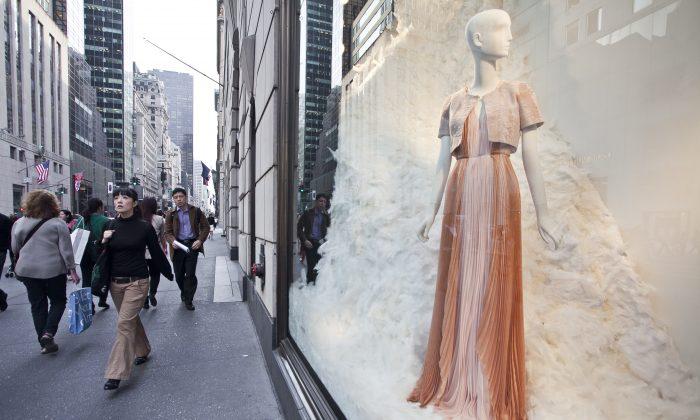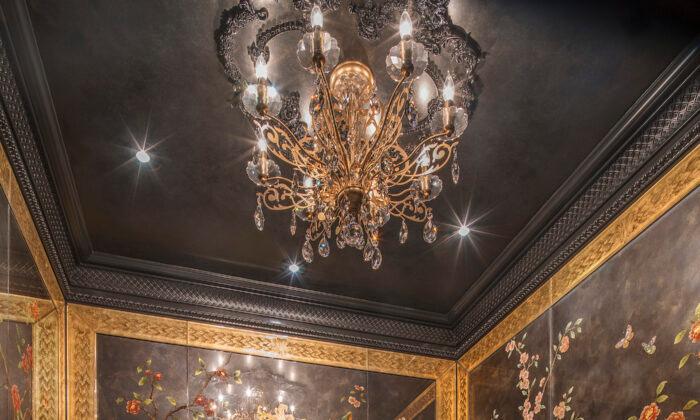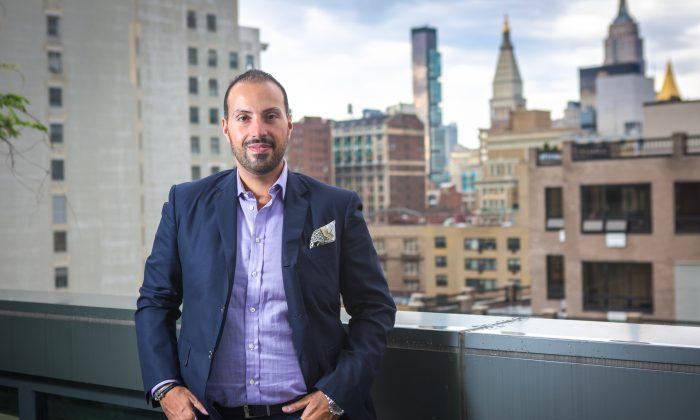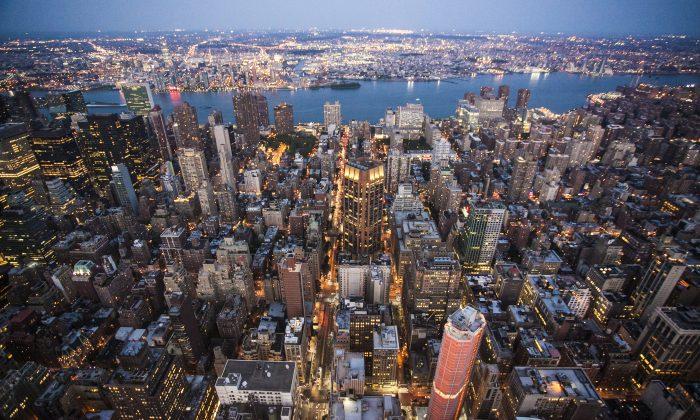NEW YORK—Luxury retailers and brand owners the world over have been vying for years for a bigger share of the highly lucrative Chinese consumer spend. Three-quarters of Chinese consumers’ luxury purchases last year were made abroad.
“The Chinese are far and away the number one luxury travel segment in the world today,” said Elizabeth Harrington, the North American publisher of The Hurun Report. They make up 35 percent of all luxury travel in the world today, and at least 30 percent of all luxury purchases."
New York City retailers are uniquely positioned. The city is one of the most desirable international business and leisure destinations for China’s elite and upper-middle class, with near three-quarters of a million Chinese visitors last year, according to the mayor’s office, cited by Crains. And the number of Chinese travelers is expected to grow 20 percent annually over the next few years.
“So that [growth] means a huge surge in sales for everyone who is in the luxury shopping business in New York,” Harrington said.
New York’s iconic luxury department store Bergdorf Goodman saw the opportunity. The retailer’s only store location is in New York, and its brand cache is built around that.
About two years ago, it began working with China Luxury Advisors on a multifaceted strategy both inside and outside China aimed at increasing its Chinese clientele.
But unlike many of its competitors who have brazenly opened locations in China’s first-tier cities, Bergdorf Goodman has been building brand recognition in China without actually going there.
Staying out of China can help companies maintain integrity and their air of exclusivity.

Most foreign luxury brands have suffered an all-too-prevalent problem of over saturating the Chinese with their marketing messages through too many brick-and-mortar stores in China, thus cheapening the image of their brands.
This is especially important as the more savvy Chinese consumers become increasingly educated about luxury hierarchies in Europe and the United States. Staying out of China can also help foreign companies avoid political complexities, such as bribery and high tariffs.
Bergdorf Goodman has built its China strategy around an understanding of the nuances of Chinese consumer behavior that brands with stores in China tend to overlook.
That is, China’s affluent consumers prefer to purchase luxury items overseas, for the experience and to guarantee authenticity. They tend to plan luxury purchases long before they leave home, and they are in many cases far younger than their Western counterparts.
Leveraging Key Influencers in China
In early 2013, Bergdorf Goodman opened Chinese social media accounts—on platforms like Weibo, a microblogging site; Tudou, a video sharing site; and WeChat, a cellphone app—to build its brand and engage shoppers before they leave China.
Social media networks are the second most important way that luxury purchasers in mainland China learn about a brand or product, with 52 percent of respondents highlighting them as important, according to Ruder Finn PR and IPSOS’s 2015 Luxury Forecast. The most important way is through word of mouth.
Leveraging Chinese social media influencers is an integral part of many luxury brands’ China strategies. In return for some form of compensation, whether an invitation to an exclusive event, a gift, or money, a Chinese social media influencer will share experiences at the store with their followers to promote the brand, or tailor a microblog around an in-store event for Chinese shoppers. A single post can fetch between $500 and $2,000, depending how much traffic or how many shares a post is expected to receive.
Consultants call these social media influencers “key opinion leaders,” or KOLs, and they fall into different categories.
A KOL that focuses on U.S. retail is likely to be based in the United States, but a beauty KOL or a fashion KOL could also be based in China or Europe, according to Brian Buchwald, CEO of Bomoda, a consumer intelligence company specializing in luxury brands in China.
Finding and suggesting influencers to use is normally the job of a consulting firm working for the luxury brand, although it sometimes may be done in-house by Chinese employees.

The strategy holds appeal for luxury brands that are trying to make a splash in China, because Chinese consumers are known for their heavy dependence on smartphone apps. Landlines are far less common in China than mobile phones, and social media apps on smartphones have even replaced standard text messaging because of the extensive features that many apps provide to users.
Business Risk
But Chinese social media platforms may not be the best way to reach China’s high-net-worth consumers. The strategy also comes with security and privacy risks, since Chinese government surveillance and control over social media networks is standard, and can have unpredictable consequences.
Almost 90 percent of luxury brands have an official Weibo account, and about 44 percent have WeChat accounts. Louis Vuitton had the most engagement per post on Weibo, Cartier had the most video views on Youku, and Coach had the most WeChat views per post, according to Bomoda’s 2015 China Luxury Blueprint.
Simon Tye from IPSOS said while it is important for luxury brands to target the Chinese, they need to understand the significance of the different segments of Chinese luxury consumers, the elevated elite versus the ones that are still buying the logos.
Researchers from the Chinese Academy of Social Sciences, in a study published in June 2013, found that 92.2 percent of Weibo users earned less than 5,000 yuan (about $805) a month, suggesting the overwhelming majority of users would not be target customers.
In the United States, brand managers are exceptionally careful about protecting the image of the brand. They would not place, or associate the brand anywhere that could damage its exclusivity cache. In the case of China, there are not a lot of choices, so an unsuitable platform like Weibo is used.
“Generally, I warn U.S. companies against using Chinese social media services,” said Eva Galperin, global policy analyst at the nonprofit digital civil liberties advocacy organization Electronic Frontier Foundation based in San Francisco, via email. “Because they will be required to censor their content.”
Any user data about the company that is available to Chinese platforms is easily available to the Chinese government, she said.
A review of Bergdorf Goodman’s Weibo and WeChat accounts show that they have remained inactive for months. However, a number of young Chinese have tagged the store on Weibo, uploaded selfie photographs or product shots, and/or provided a few comments about the store, and sometimes the restaurant.
“It appears that Bergdorf has really looked to leverage third-party social followings rather than trying to really build up their own,” Buchwald said.
Welcome to New York
In an announcement in 2013, Bergdorf Goodman said it would accept China Union Pay, a prefered payment method for Chinese travelers. This signalled an open-arms welcome of the Chinese buyer.
Around that time, it also hired Mandarin-speaking greeters with Chinese name tags in both its women’s and men’s stores to assist mainland tourists with limited English and communicate the history and heritage of the store.
Bergdorf Goodman has also leveraged a rising trend among Chinese outbound tourists: the popularity of Western-style afternoon tea at aspirational destinations.

Visitors can enjoy a late afternoon tea, complete with sandwiches, freshly baked scones, and a variety of petite sweets, placed on three-tiered silver cake stands at the Bergdorf Goodman restaurant.
Bergdorf Goodman has also tapped online Chinese influencers residing in New York, encouraging them to invite their friends and fans on social media to learn about and experience the store.
Many experts believe the most important way to promote brand awareness is through word-of-mouth from people the prospective consumer knows personally.
Tour Operators Model Shortsighted
According to Buchwald, brands often pay tour operators to bring shoppers to their stores. It is a pretty common practise in New York and other major tourist cities, including in Europe. Bergdorf Goodman also uses the strategy.
However, “We think that model is somewhat challenged,” he said.
“First of all, there’s an economic cost doing business with the tour operators, but the bigger reason is the Chinese consumer is becoming more educated and more independent, and their desire to be on tour buses and be dropped off for a few hours at a time is being substituted by their ability to create their own agendas, to leverage mobile apps, to create their own schedules,” said Buchwald.
“The average Chinese luxury consumer is about 20 years younger than their Western peers,” he said. “So where a 50-year-old may be more apt to go on a tour and get off on a tour bus, a 25-year-old or 30-year-old is going to be less apt to do so.”
Buchwald said Bergdorf Goodman, however, had effectively timed in-store events with Chinese holidays and Chinese travel periods to attract clientele.
“They’ve even looked to bring in Chinese students and wealthy individuals who are living here in the states,” he said.
Why Chinese Buy Overseas
Chinese prefer to buy luxury products overseas for three key reasons, according to Harrington.
Tariffs in China mean that luxury products can be 30 percent more expensive. In China there is concern that even official stores may sell counterfeit goods—and most importantly, Chinese luxury shoppers have become very sophisticated and are looking to enjoy the experience of the brands they purchase.

An anti-corruption campaign, where China’s leader Xi Jinping has systematically cracked down on graft and corruption within state-run and private businesses, has also helped push more purchases abroad where they can’t be traced. The result, according to Harrington, is that although there has been a 10 percent drop in luxury purchasing in China, Chinese consumers have spent 20–30 percent more in the United States.
“We know that Bergdorf’s program is effective because our Hurun Report readers [Chinese high-net-wealth individuals] elected them a must-see destination in New York,” Harrington said.
Bergdorf Goodman declined to comment for this article.






Friends Read Free